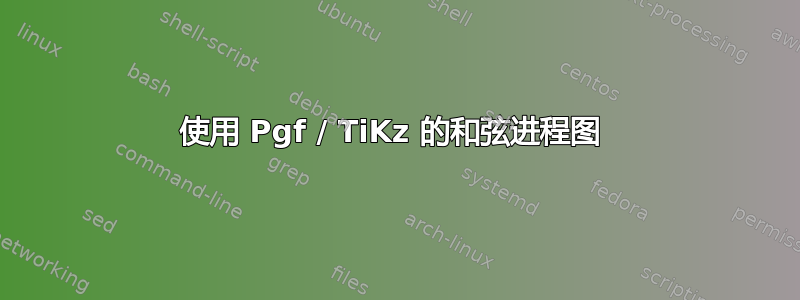
需要使用 Pgf / TiKz 实现一个和弦进行图用于音乐讲座。基本代码如下:
\documentclass{article}
\usepackage{tikz}
\usetikzlibrary{positioning, fit, calc, shapes, arrows}
\renewcommand{\figurename}{Figure}
\usepackage{musixtex}
\begin{document}
\begin{figure}[!htb]
\centering
\begin{tikzpicture}
[parent anchor=east,child anchor=west,grow=east]
\tikzstyle{title}=[font=\fontsize{18}{18}\color{green!65}\sffamily]
\tikzstyle{raiz}=[ball color=white,circle,text=black,anchor=west]
\tikzstyle{edge from parent}=[draw=none,dashed,thick,red]
\node [title] (romanNumber) at (1.5, 4) {I};
\node[raiz] (ch0) {C}
child {node[right] (ch5) {maj6}}
child {node[right] (ch4) {maj6/9}}
child {node[right] (ch3) {maj9}}
child {node[right] (ch2) {maj7}}
child {node[right] (ch1) {maj}};
\node[fit=(romanNumber)(ch0)(ch5)(ch1)(ch4), draw,rounded corners=0.5cm] {};
\end{tikzpicture} \qquad
\begin{tikzpicture}
[parent anchor=east,child anchor=west,grow=east]
\tikzstyle{title}=[font=\fontsize{18}{18}\color{green!65}\sffamily]
\tikzstyle{raiz}=[ball color=white,circle,text=black,anchor=west]
\tikzstyle{edge from parent}=[draw=none,dashed,thick,red]
\node [title] (romanNumber) at (1.5, 3) {iii};
\node[raiz] (ch0) {E}
child {node[right] (ch4) {maj6}}
child {node[right] (ch3) {min9}}
child {node[right] (ch2) {min7}}
child {node[right] (ch1) {min}};
\node[fit=(romanNumber)(ch0)(ch1)(ch4), draw,rounded corners=0.5cm] {};
\end{tikzpicture} \qquad
\begin{tikzpicture}
[parent anchor=east,child anchor=west,grow=east]
\tikzstyle{title}=[font=\fontsize{18}{18}\color{green!65}\sffamily]
\tikzstyle{raiz}=[ball color=white,circle,text=black,anchor=west]
\tikzstyle{edge from parent}=[draw=none,dashed,thick,red]
\node [title] (romanNumber) at (1.5, 2.5) {vi};
\node[raiz] (ch01) {A}
child {node[right] (ch11) {min9}}
child {node[right] (ch12) {min7}}
child {node[right] (ch13) {min}};
\node[below = 2cm of ch01,raiz] (ch02) {C}
child {node[right] (ch12) {maj6}};
\node[fit=(romanNumber)(ch01)(ch11)(ch02)(ch12), draw,rounded corners=0.5cm] {};
\end{tikzpicture} \qquad
\begin{tikzpicture}
[parent anchor=east,child anchor=west,grow=east]
\tikzstyle{title}=[font=\fontsize{18}{18}\color{green!65}\sffamily]
\tikzstyle{raiz}=[ball color=white,circle,text=black,anchor=west]
\tikzstyle{edge from parent}=[draw=none,dashed,thick,red]
\node [title] (romanNumber) at (1.5, 3) {ii};
\node[raiz] (ch01) {D}
child {node[right] (ch11) {min9}}
child {node[right] (ch12) {min7}}
child {node[right] (ch13) {min}};
\node[below = 2cm of ch01,raiz] (ch02) {F}
child {node[right] (ch12) {maj6}};
\node[fit=(romanNumber)(ch01)(ch11)(ch02)(ch12), draw,rounded corners=0.5cm] {};
\end{tikzpicture} \qquad
\begin{tikzpicture}
[parent anchor=east,child anchor=west,grow=east]
\tikzstyle{title}=[font=\fontsize{18}{18}\color{green!65}\sffamily]
\tikzstyle{raiz}=[ball color=white,circle,text=black,anchor=west]
\tikzstyle{edge from parent}=[draw=none,dashed,thick,red]
\node [title] (romanNumber) at (1.5, 4) {IV};
\node[raiz] (ch01) {D}
child {node[right] (ch11) {maj6}}
child {node[right] (ch12) {maj6/9}}
child {node[right] (ch12) {maj9}}
child {node[right] (ch12) {maj7}}
child {node[right] (ch13) {maj}};
\node[below = 4.1cm of ch01,raiz] (ch02) {D}
child {node[right] (ch12) {min7}};
\node[fit=(romanNumber)(ch01)(ch13)(ch02)(ch12), draw,rounded corners=0.5cm] {};
\end{tikzpicture} \qquad
\begin{tikzpicture}
[parent anchor=east,child anchor=west,grow=east]
\tikzstyle{title}=[font=\fontsize{18}{18}\color{green!65}\sffamily]
\tikzstyle{raiz}=[ball color=white,circle,text=black,anchor=west]
\tikzstyle{edge from parent}=[draw=none,dashed,thick,red]
\node [title] (romanNumber) at (1.5, 4) {I};
\node[raiz] (ch0) {C}
child {node[right] (ch5) {maj6}}
child {node[right] (ch4) {maj6/9}}
child {node[right] (ch3) {maj9}}
child {node[right] (ch2) {maj7}}
child {node[right] (ch1) {maj}};
\node[fit=(romanNumber)(ch0)(ch5)(ch1)(ch4), draw,rounded corners=0.5cm] {};
\end{tikzpicture} \qquad
\begin{tikzpicture}
[parent anchor=east,child anchor=west,grow=east]
\tikzstyle{title}=[font=\fontsize{18}{18}\color{green!65}\sffamily]
\tikzstyle{raiz}=[ball color=white,circle,text=black,anchor=west]
\tikzstyle{edge from parent}=[draw=none,dashed,thick,red]
\node [title] (romanNumber) at (1.5, 3) {V};
\node[raiz] (ch01) {G}
child {node[right] (ch11) {7\#5}}
child {node[right] (ch12) {dom9}}
child {node[right] (ch12) {dom7}}
child {node[right] (ch13) {maj}};
\node[below = 2.5cm of ch01,raiz] (ch02) {Db}
child {node[right] (ch12) {dom7}};
\node[fit=(romanNumber)(ch01)(ch11)(ch02)(ch12), draw,rounded corners=0.5cm] {};
\end{tikzpicture} \qquad
\begin{tikzpicture}
[parent anchor=east,child anchor=west,grow=east]
\tikzstyle{title}=[font=\fontsize{18}{18}\color{green!65}\sffamily]
\tikzstyle{raiz}=[ball color=white,circle,text=black,anchor=west]
\tikzstyle{edge from parent}=[draw=none,dashed,thick,red]
\node [title] (romanNumber) at (1.5, 2) {vii};
\node[raiz] (ch01) {B}
child {node[right] (ch11) {m7b5}}
child {node[right] (ch12) {dim}};
\node[below = 1.5cm of ch01,raiz] (ch02) {D}
child {node[right] (ch21) {min6}};
\node[fit=(romanNumber)(ch01)(ch11)(ch02)(ch21), draw,rounded corners=0.5cm] {};
\end{tikzpicture}
\caption{Chord Progression Map}
\end{figure}
\end{document}
期望的输出如下:
编辑
现在,基本代码如下:
\documentclass{article}
%\documentclass[tikz]{standalone}
\usepackage{musixtex}
\usepackage{tikz}
\usetikzlibrary{arrows.meta, graphs, chains, ext.paths.ortho, ext.positioning-plus}
\begin{document}
\begin{tikzpicture}[
chord list/.style args={#1/#2:#3}{
matrix, rectangle, draw={#1}, fill={#1!10}, rounded corners, thick, name=#2,
label={[anchor=north, node font=\Large\sffamily, text={#1}]north:{#2}},
node contents={\tikzset{create chord list={#2}{#3}}\pgfmatrixendrow}},
circ node/.style={
thin, draw, fill=white, circle, inner sep=+.15em,
text width=width("D$\flat$"), align=center},
chord node/.style={inner xsep=+.15em, text depth=+0pt},
create chord list/.code 2 args={
\tikzset{node distance=+.2em and +.5em, start chain=chord#1 going west below, anchor=center}
\path (up:2.3em);
\foreach[remember=\first (initially 1), count=\i] \t/\N in {#2}{
\foreach \n in \N \node[on chain, chord node] {\n};
\node[circ node, left=of (chord#1-\first)(chord#1-\tikzchaincount)] (chord#1-label-\i) {\t};
\unless\ifnum\first=\tikzchaincount\relax
\path[black, thin] (chord#1-label-\i)
edge (chord#1-\first.mid west) edge (chord#1-\tikzchaincount.mid west);
\fi
\edef\first{\pgfinteval{\tikzchaincount+1}}}}]
%% Inicia dibujo
\draw[thick,-LaTeX] (1.4,5.6) -- ++(-1:0.6);
\draw[thick,-LaTeX] (1.4,4.5) -- ++(-20:0.6);
\draw[thick,-LaTeX] (1.4,3.2) -- ++(-40:0.6);
\draw[thick,-LaTeX] (0.5,2.7) -- ++(-70:0.6);
\draw[thick,-LaTeX] (-0.3,2.7) -- ++(-95:0.6);
\matrix[ chord list=green/iii:E/{min, min7, min9, maj6}];
\matrix[above=1.5cm of iii, chord list=green/I:C/{maj, maj7, maj9, maj6/9, maj6}];
\matrix[north right= of iii, chord list=green/vi:{A/{min, min7, min9}, C/maj6}];
\matrix[north right= of vi, chord list=blue/ii:{F/{min, min7, min9}, F/maj6}];
\matrix[north right= of ii, chord list=blue/IV:{F/{maj, maj7, maj9, maj6/9, maj6}, D/min7}];
\matrix[north right=2:of IV, chord list=green/I:C/{maj, maj7, maj9, maj6/9, maj6}];
\matrix[above=.5cm of (IV)(I),chord list=red/V:{G/{maj, dom7, dom9, 7$\sharp$5}, D$\flat$/dom7}];
\matrix[below=.5cm of (IV)(I),chord list=red/vii:{B/{dim, m7$\flat$5}, D/min6}];
\graph[
edges={thick, >=Latex, only horizontal first},
use existing nodes,
oi/.style args={#1:#2}{out={#1}, in={#2}}]{
iii -> vi -> ii -> IV <->[only horizontal second] I,
iii ->[bend left, left anchor=north, right anchor=90] ii,
vi <->[bend right, left anchor=south, right anchor=230] IV,
iii <-[oi=-90:200] vii,
V <->[oi= 0: 90] I,
(V.200) <->[oi=180: 90] IV,
V <-[oi=180: 85] ii,
(V.160) <->[oi=180: 90] vi,
ii ->[oi=-90:180] vii,
IV ->[oi=-90:160] vii
->[oi= 0:-90] I
};
\end{tikzpicture}
\end{document}
解决了 !!!
答案1
这里开始为每个盒子使用一个矩阵,并为最小/最大节点使用一个链。
代码
\documentclass[tikz]{standalone}
\usetikzlibrary{arrows.meta, graphs, chains, ext.paths.ortho, ext.positioning-plus}
\begin{document}
\begin{tikzpicture}[
chord list/.style args={#1/#2:#3}{
matrix, rectangle, draw={#1}, fill={#1!10}, rounded corners, thick, name=#2,
label={[anchor=north, node font=\Large\sffamily, text={#1}]north:{#2}},
node contents={\tikzset{create chord list={#2}{#3}}\pgfmatrixendrow}},
circ node/.style={
thin, draw, fill=white, circle, inner sep=+.15em,
text width=width("D$\flat$"), align=center},
chord node/.style={inner xsep=+.15em, text depth=+0pt},
create chord list/.code 2 args={
\tikzset{node distance=+.2em and +.5em, start chain=chord#1 going west below, anchor=center}
\path (up:2.3em);
\foreach[remember=\first (initially 1), count=\i] \t/\N in {#2}{
\foreach \n in \N \node[on chain, chord node] {\n};
\node[circ node, left=of (chord#1-\first)(chord#1-\tikzchaincount)] (chord#1-label-\i) {\t};
\unless\ifnum\first=\tikzchaincount\relax
\path[black, thin] (chord#1-label-\i)
edge (chord#1-\first.mid west) edge (chord#1-\tikzchaincount.mid west);
\fi
\edef\first{\pgfinteval{\tikzchaincount+1}}}}]
\matrix[ chord list=green/iii:E/{min, min7, min9, maj6}];
\matrix[north right= of iii, chord list=green/vi:{A/{min, min7, min9}, C/maj6}];
\matrix[north right= of vi, chord list=blue/ii:{F/{min, min7, min9}, F/maj6}];
\matrix[north right= of ii, chord list=blue/IV:{F/{maj, maj7, maj9, maj6/9, maj6}, D/min7}];
\matrix[north right=2:of IV, chord list=green/I:C/{maj, maj7, maj9, maj6/9}];
\matrix[above=.5cm of (IV)(I),chord list=red/V:{G/{maj, dom7, dom9, 7$\sharp$5}, D$\flat$/dom7}];
\matrix[below=.5cm of (IV)(I),chord list=red/vii:{B/{dim, m7$\flat$5}, D/min6}];
\graph[
edges={thick, >=Latex, only horizontal first},
use existing nodes,
oi/.style args={#1:#2}{out={#1}, in={#2}}]{
iii -> vi -> ii -> IV <->[only horizontal second] I,
iii ->[bend left, left anchor=north, right anchor=95] ii,
V <->[oi= 0: 90] I,
(V.200) <->[oi=180: 90] IV,
V ->[oi=180: 90] ii,
(V.160) <->[oi=180: 90] vi,
IV ->[oi=-90:180] vii
->[oi= 0:-90] I
};
\end{tikzpicture}
\end{document}






